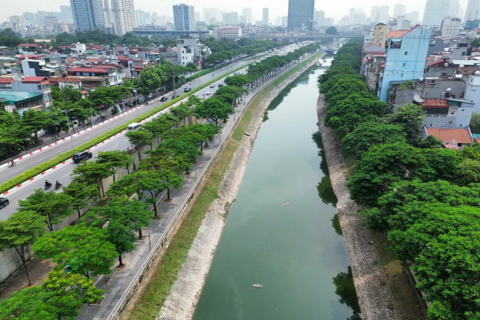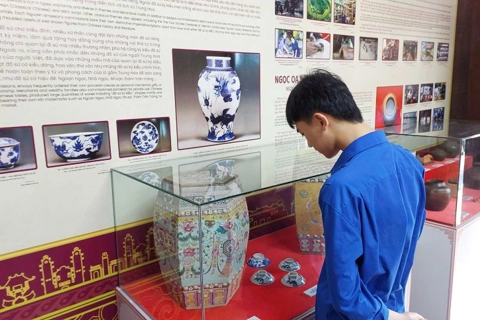Double-decker bus tour to explore Hanoi's historical landmarks
On a double-decker bus ride through the capital, Hanoi residents are in awe of the sights and historical landmarks that have endured for thousands of years.
As they hum songs expressing their love for Vietnam's capital, they are filled with a deep sense of pride, knowing that they were born and raised in this land rich in national identity. They have witnessed the city's ups and downs, as well as the heroic marks left by its people and army during years of fighting invaders.
| Hanoians sing out loud songs expressing their love for the capital. Photo: Tung Lam/The Hanoi Times |
In celebration of the 70th anniversary of the liberation of the capital, the double-decker bus is offering free tickets to explore famous Hanoi landmarks such as Dien Hong Garden, the Vietnam Military History Museum, Thang Long Imperial Citadel, Ho Chi Minh Mausoleum, Temple of Literature and Quan Thanh Temple.
| The double-decker bus takes visitors on a tour of Hanoi's famous landmarks. Photo: Tung Lam/The Hanoi Times |
For 72-year-old Nguyen Thi Minh Truc, it's a chance to take in the panoramic view of the city and see the landmarks associated with the capital's birth and development from above. "This is a wonderful experience," she told The Hanoi Times.
The first stop on the tour is Dien Hong Garden. Set in the heart of Hanoi, this park was originally built during the French colonial period and named Independence Garden. It was renamed Dien Hong Garden in 1946 in honor of the Dien Hong Conference of 1284, a powerful symbol of national unity against foreign invasion.
Today, the park is not only a green oasis in the heart of the city but also a venue for many important cultural and political events. Close to the National Assembly building, the park underscores the link between history and the present and plays a key role in preserving and promoting the nation's cultural values.
| Dien Hong Garden is an outstanding work that blends Western and Eastern architectural styles. Photo: Ngoc Tu/The Hanoi Times |
Next on the itinerary is the Vietnam Military History Museum, one of the proud symbols of Vietnam's history of nation-building and defense. Founded in 1956, the museum displays over 150,000 artifacts that recount the history of the nation's struggle for independence, especially the wars of resistance against the French and Americans.
The museum has both indoor and outdoor exhibits, with remarkable items such as tanks, aircraft, and weapons used in historical battles. It is a place that showcases the indomitable spirit and patriotism of the Vietnamese army.
| The Vietnam Military History Museum. Photo: Vietnam National Authority of Tourism |
Then the tour arrives at the Thang Long Imperial Citadel, a historical site closely tied to Vietnam's royal dynasties. Built in the 11th century under the Ly dynasty, the citadel was the political and cultural center of the country for many periods of the nation's history.
The site includes the archaeological site at 18 Hoang Dieu Street and the iconic Hanoi Flag Tower. In 2010, the Citadel was inscribed on UNESCO's World Heritage List, underscoring its important role in Vietnam's history.
| The Thang Long Imperial Citadel. Photo: Vietnam National Authority of Tourism |
During the trip, Truc waxed nostalgic about the old Hanoi. Having come to Hanoi in 1959, she has witnessed countless changes and events surrounding the city, from its most difficult times to its most successful moments.
She recounted the hardships and shortcomings of Hanoi's infrastructure and transportation in the past. In particular, transportation relied on basic means such as bicycles and old trams. To make matters worse, the war destroyed many buildings, hospitals, and schools, threatening the lives of the city's residents.
| Truc, wearing sunglasses on the left, has seen many of Hanoi's milestones. Photo: Tung Lam/The Hanoi Times |
Still, she was amazed by the city's resilience and indomitable spirit. Over the years, Hanoi has risen powerfully to become one of the world's most livable cities. Skyscrapers and modern, spacious houses have continued to rise, and the infrastructure has become increasingly modern. She hopes to continue to witness the development and progress of Vietnam's capital in the future.
The double-decker bus then proceeded to the Ho Chi Minh Mausoleum, where the revered leader of the Vietnamese people rests in peace. Completed in 1975, this monument in Ba Dinh Square is of immense historical and cultural significance, representing the deep respect and gratitude of the Vietnamese people for President Ho Chi Minh.
The architecture of the mausoleum is both simple and dignified, constructed mainly of stone and marble. Inside, the body of President Ho Chi Minh is preserved in a serene and respectful environment. Every day, thousands of citizens and international visitors come to pay their respects and honor the man who dedicated his life to the country's independence and freedom.
| The Ho Chi Minh Mausoleum. Photo: The Hanoi Times |
The Ho Chi Minh Mausoleum is not only a historical landmark, but also a place that strengthens national pride, preserves traditional values, and inspires patriotism among the Vietnamese people.
Other famous sites visited on the bus tour include Quan Thanh Temple and the Temple of Literature. As the city celebrates its 70th year of independence, this tour offers visitors an up-close look at the remarkable development and changes the capital has undergone over time.
| The people of Hanoi are very proud to be a part of the capital city. Photo: Tung Lam/The Hanoi Times |
Another passenger on the double-decker bus, Nguyen Thi Phuong, a 63-year-old resident of Cau Giay District, shared her pride in being part of the capital. "During this 70th anniversary of liberation, I've spent most of my free time taking photos with friends at famous landmarks in Hanoi to capture the city's beautiful moments," she said.
In contrast to previous years' simpler celebrations brought on by challenging conditions, this year's event is incredibly large and well-planned in both form and content. This is a sign of robust social and economic development," Phuong told The Hanoi Times.

.jpg)
.jpg)
.jpg)
.jpg)
.jpg)
.jpg)
.jpg)
.jpg)








